Tom's Hardware Verdict
Aside from a calibration anomaly that cuts light output, the MPG271QRX has no real flaws. Its gaming performance is matched only by other 240 and 360 Hz OLEDs. Once you see it in action, you’ll want it.
Pros
- +
Next level gameplay with instant response and smooth motion processing
- +
Stunning HDR and SDR image with deep contrast and rich color
- +
Accurate color out of the box with no need for calibration
- +
Solid build quality and attractive styling
Cons
- -
Calibration reduces light output by half
- -
Confusing picture modes that are split into two menus
Why you can trust Tom's Hardware
With so many fast OLEDs becoming available, it’s a great time for gamers looking for the best gaming monitors with the ultimate in performance and image quality. We’re seeing screens in multiple shapes and sizes, but one emerging category is 27-inch flat panels with QHD resolution. Since there are fewer pixels to move about than 4K, QHD affords higher frame rates. Most of them hit 240 Hz, but now, 360 Hz displays are becoming plentiful.
MSI’s entry is the MPG271QRX. Its 27-inch flat panel is a QD-OLED, which means wide gamut color, very wide as you’ll soon see. It also hits 360 Hz, runs both flavors of Adaptive-Sync and supports HDR10 with over 400 nits of peak output. Let’s take a look.
MSI MPG271QRX Specs
| Panel Type / Backlight | Quantum Dot |
| Row 1 - Cell 0 | Organic Light-Emitting Diode |
| Row 2 - Cell 0 | (QD-OLED) |
| Screen Size / Aspect Ratio | 27 inches / 16:9 |
| Max Resolution and Refresh Rate | 2560x1440 @ 360 Hz |
| Row 5 - Cell 0 | FreeSync: 48-360 Hz |
| Row 6 - Cell 0 | G-Sync Compatible |
| Native Color Depth and Gamut | 10-bit / DCI-P3+ |
| Response Time (GTG) | 0.03ms |
| Brightness (mfr) | 250 nits SDR |
| Row 10 - Cell 0 | 1,000 nits HDR |
| Contrast | Unmeasurable |
| Speakers | None |
| Video Inputs | 1x DisplayPort 1.4 |
| Row 14 - Cell 0 | 2x HDMI 2.1, 1x USB-C |
| Audio | 3.5mm headphone output |
| USB 2.0 | 1x up, 2x down |
| Power Consumption | 43w, brightness @ 200 nits |
| Panel Dimensions WxHxD w/base | 24 x 16.5-20.9 x 9.5 inches (610 x 419-531 x 241mm) |
| Panel Thickness | 2.7 inches (68mm) |
| Bezel Width | Top: 0.2 inch (6mm) |
| Row 21 - Cell 0 | Sides: 0.5 inch (12mm) |
| Row 22 - Cell 0 | Bottom: 0.8 inch (20mm) |
| Weight | 18.4 pounds (8.4kg) |
| Warranty | 3 years |
This is the second 360 Hz OLED I’ve encountered, the first being Alienware’s AW2725DF. The MPG271QRX is also based on a Samsung Quantum Dot OLED panel. QD-OLED is currently the most colorful of all OLED variants. Indeed, my sample rendered over 109% of DCI-P3. That’s a difference you can plainly see when comparing it to other wide-gamut screens that hit around 90%. The bar is being raised, for sure.
A 360 Hz refresh rate means super smooth motion resolution. With no need for overdrive, OLED as a category is well suited for gaming. It is smoother at a given frame rate than LCD. To match the performance of even a 240 Hz OLED, you’ll need a 360 or 500 Hz LCD. The MPG271QRX delivers all that and low input lag as well. And its QHD resolution is a lighter load for PCs and consoles alike. Two HDMI 2.1 ports also support 360 Hz along with VRR and a 48Gbps data rate. Adaptive-Sync is supported on both FreeSync and G-Sync platforms. The MPG271QRX has not been certified by Nvidia at this writing.
As a premium display, the MPG271QRX offers a full suite of gaming aids, like sniper mode, aiming points, timers, and a frame counter. A cool-looking MSI logo lights up in the back with colored LEDs, and the styling is high-end gaming all the way, with molded-in accents and a stout stand.
The price is around $800, so it is a premium option. But as I’ve said about other OLEDs, once you’ve tried it, you’ll want it. My first impression of the MPG271QRX is no different. It looks as good as all the other OLEDs I’ve reviewed.
Assembly and Accessories
My sample arrived double-boxed with large blocks of crumbly foam inside. The upright, base and panel are substantial and assemble quickly without tools. Bundled cables include HDMI, IEC power and USB. There was no DisplayPort cable with my sample, which is unusual. It is the best way to connect the MPG271QRX.
Get Tom's Hardware's best news and in-depth reviews, straight to your inbox.
Product 360
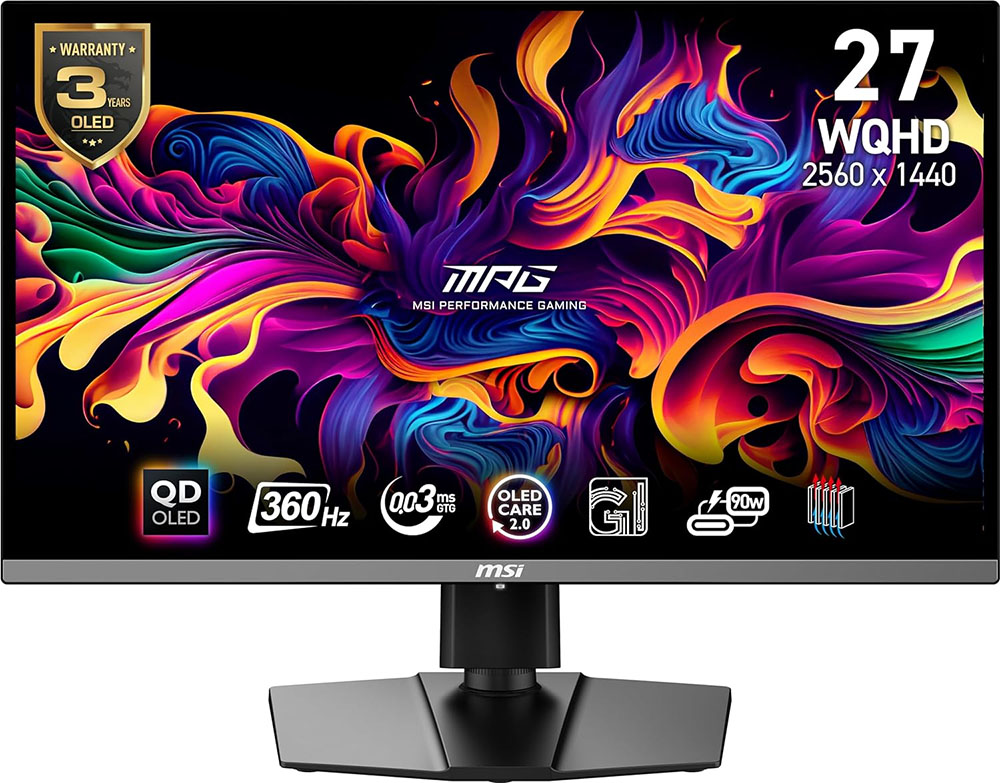
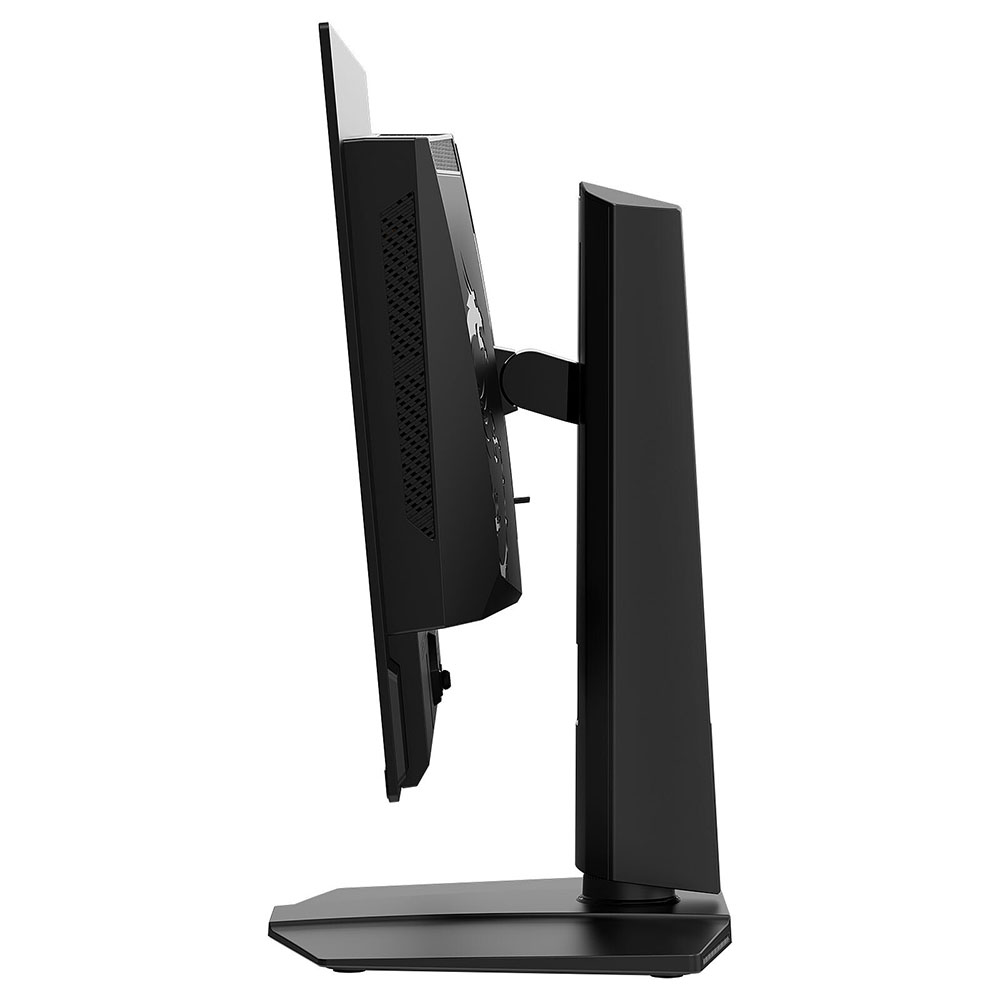
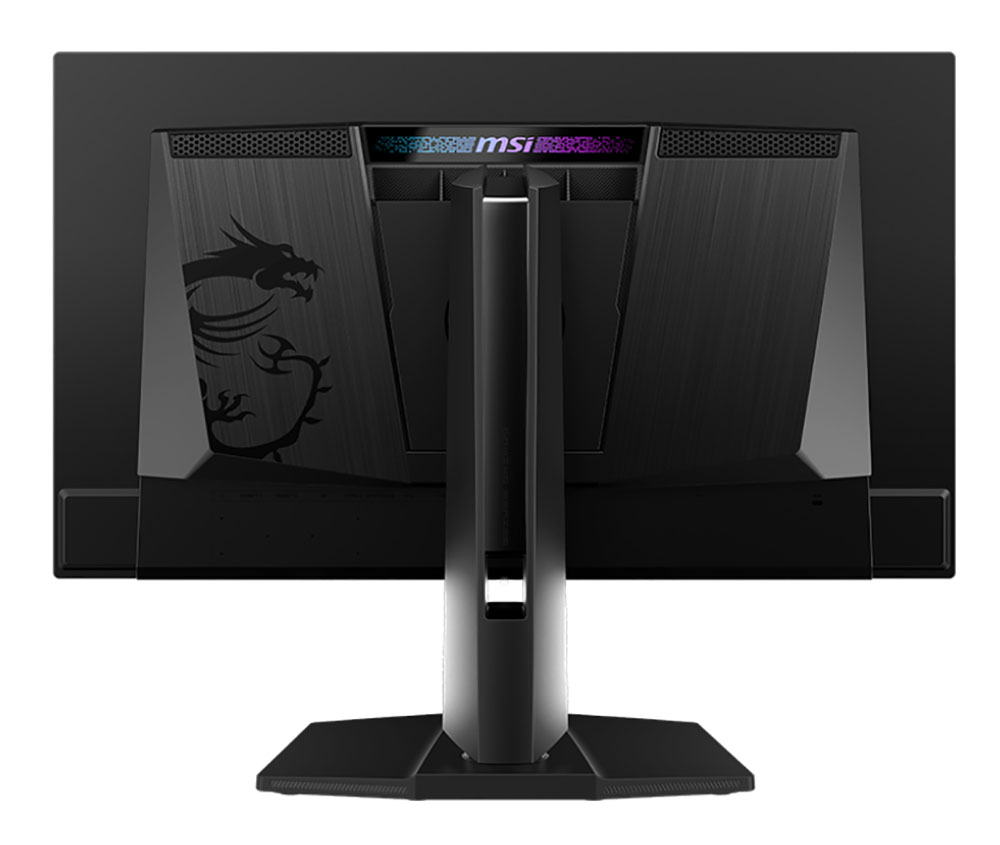
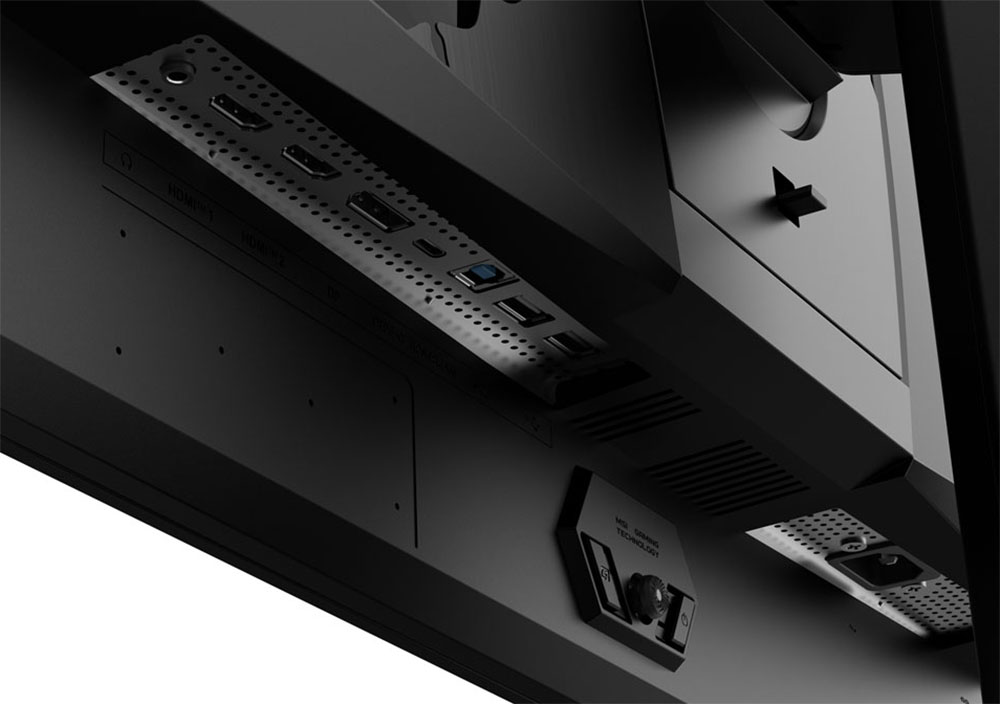
The MPG271QRX embodies classic OLED styling where the panel is attached to a component bulge. The panel is just 4mm thick with a metal backing. The bulge brings the total depth up to 68mm (2.7 inches) which is typical for a 27-inch monitor. The panel incorporates a graphene layer to aid cooling and there is copious ventilation around all sides of the bulge. Heat will never be a problem here.
The bulge features molded textures that form a dragon logo and a brushed finish that easily passes for metal. It’s heavy plastic, but it looks very high-end. The MSI logo sits atop the bulge and lights up in all colors of the spectrum. The color effect is fixed, but you can vary its brightness or shut it off if you wish.
The stand is solid and has full ergonomics. The height adjustment is 4.4 inches, and you get 30 degrees swivel, 5/21 degrees tilt, and a 90-degree portrait mode. Movements are smooth and firm, with the premium feedback expected from a monitor at this price point.
Underneath the center of the panel is a joystick with two flanking buttons. One toggles power and the other activates a desktop control app if you’ve made a USB connection. Further underneath are the inputs. You get two HDMI 2.1 and one each of DisplayPort 1.4 and USB-C. All support 2560x1440 resolution up to 360 Hz with Adaptive-Sync and HDR. The USB-C port also supports charging up to 90 watts. Additional USB ports include one upstream and two down, version 2.0, for peripherals. Headphones can be plugged into the 3.5mm audio jack, but there are no internal speakers.
OSD Features
Pressing the MPG271QRX’s joystick brings up a comprehensive OSD with just about everything one could need for gaming and image control.
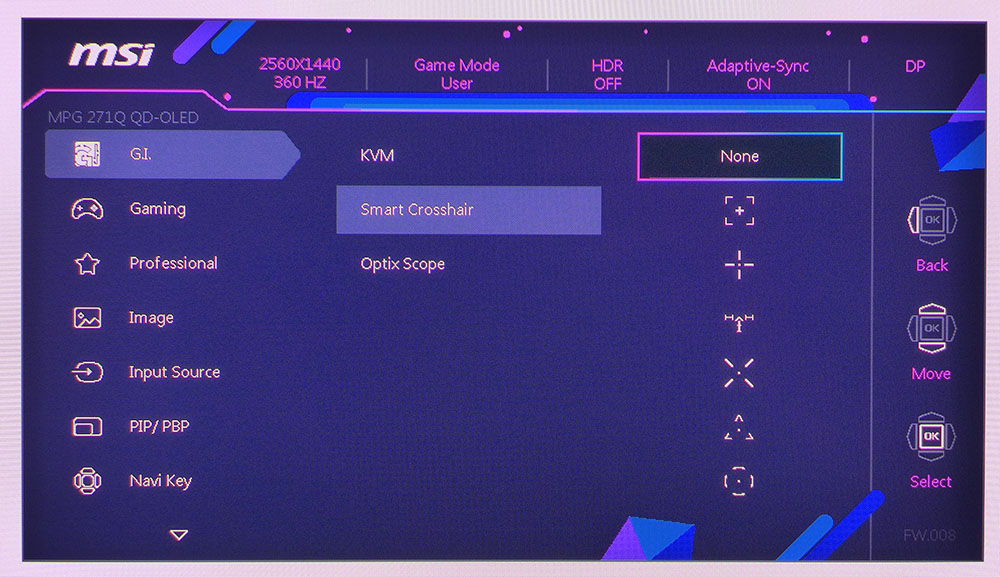
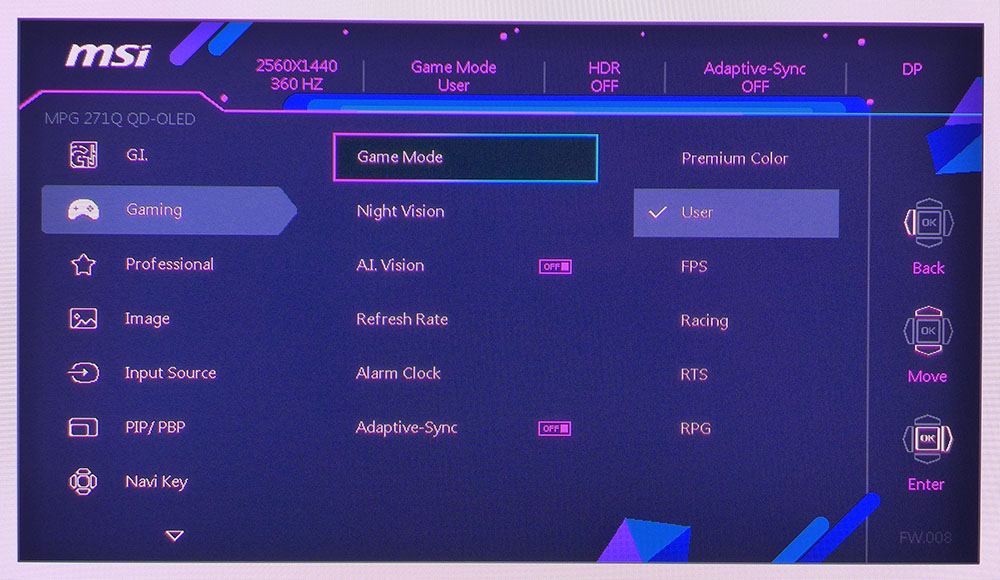
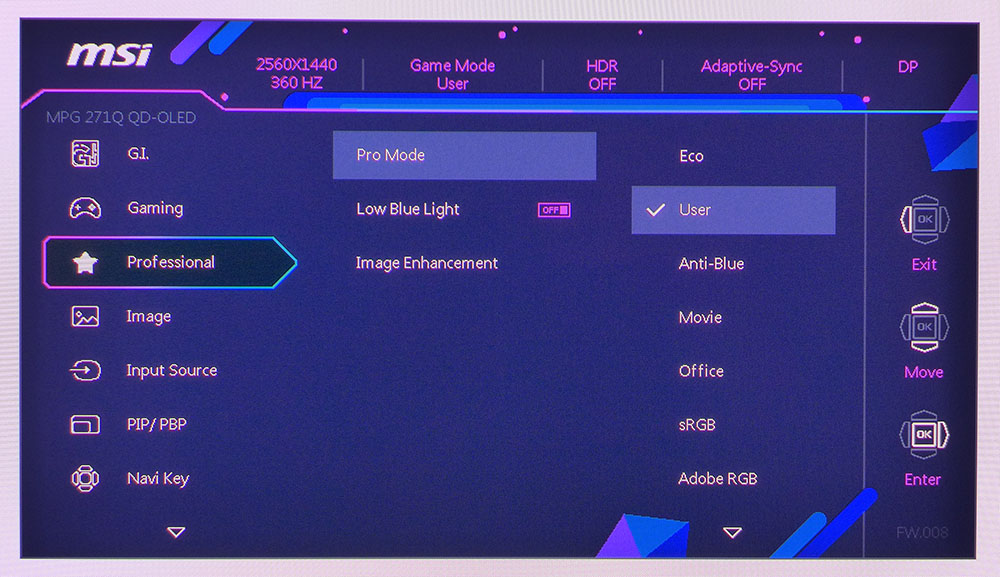
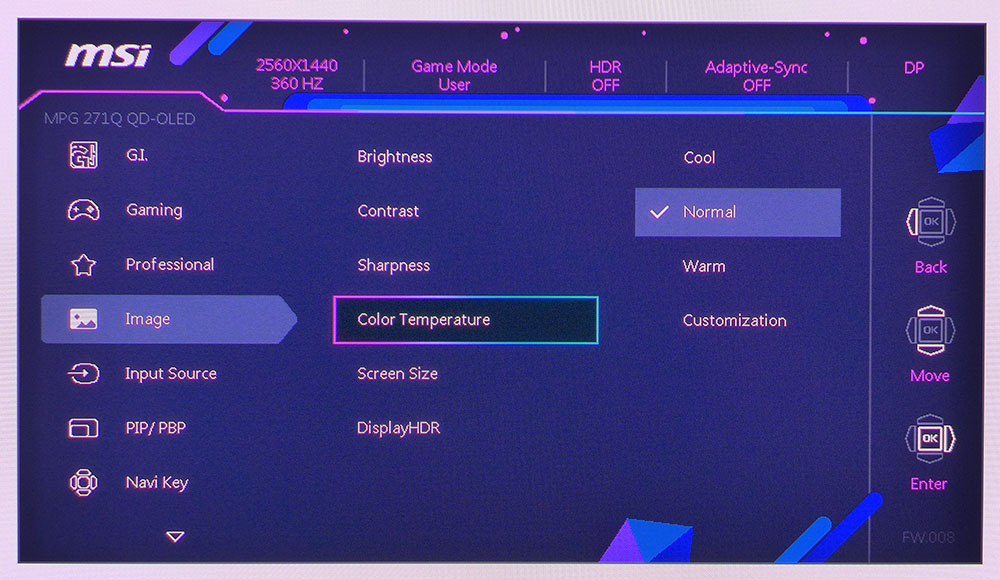

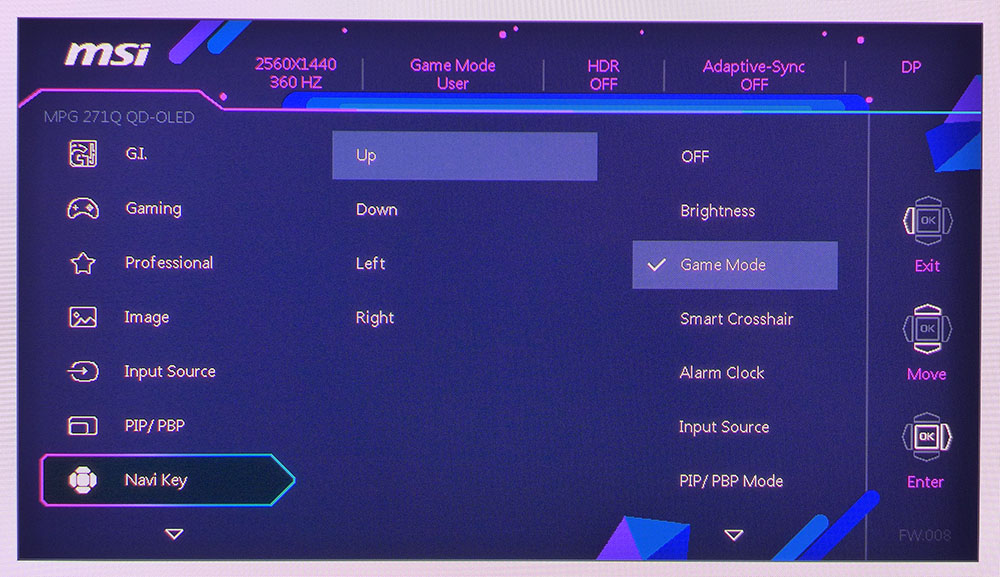
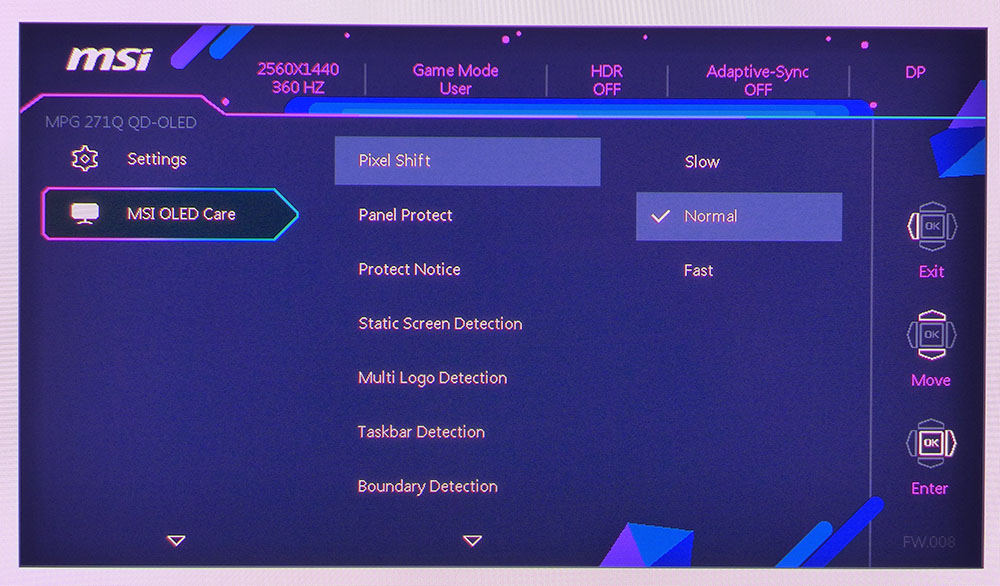
In the first menu, G.I., are the KVM settings along with a selection of aiming points and a sniper mode. The crosshairs can be a fixed color or set to change with content in real time to maintain a contrasting color. Optix Scope is a sniper mode with three window sizes and three magnifications.
The MPG271QRX has a confusing approach to picture modes. First, in the Gaming menu, are a series of presets that correspond to different game types. Suggestion: stick with Premium Color or User. Then, in the Professional menu, there is another list of presets aimed at productivity. Suggestion: go with User for the full native color gamut or sRGB for the smaller space.
Back to the Gaming menu, Night Vision is a shadow detail enhancer; you won’t need it. A.I. Vision is a subtle dynamic contrast option; you won’t need that either. The MPG271QRX has typical OLED contrast, which is vast. It also has accurate gamma, so it won’t need help in the shadow detail department. Additional options activate a frame counter, countdown timer, and Adaptive-Sync toggle.
The Image menu has three fixed color temps and a user mode. I suggest you stick with the Normal option. It is possible to calibrate the MPG271QRX but choosing Customization cuts light output by half. Luckily, color is on-point out of the box, so you won’t need to make any adjustments for the sake of accuracy. Also here are the two HDR modes, True Black 400 and Peak 1000 nits. The best choice is True Black because it has near-perfect tone mapping.
The joystick can be programmed to quickly access frequently used settings like aiming points, brightness, and picture modes. The final menu, MSI OLED Care, has many options for panel and pixel refresh and other methods of preventing burn-in. OLED burn-in is possible, though difficult to achieve. You can turn on features to detect taskbars, logos and image borders. The MPG271QRX will reduce output in those areas of the screen. With so many ways to maintain the panel, it’s unlikely you’ll ever see a problem.
MSI MPG271QRX Calibration Settings
I wish I could tell you how to calibrate the MPG271QRX, but unfortunately, I can’t recommend that you employ the custom color temp option because it cuts light output by half. It’s also true that no adjustments are necessary. A calibration data sheet is provided with each sample and in my case, the numbers matched up perfectly, even down to the measured color gamut volume of 109%. Stick with the Normal color temp and just adjust the brightness to taste and you’ll be fine. Use either Premium Color or User in the Game menu and set the Professional option to User. That is all. My brightness settings are provided below.
In HDR mode, the True Black 400 mode provides the most accurate luminance tracking, grayscale and color gamut.
| Picture Mode | Premium Color/User |
| Brightness 200 nits | 65 |
| Brightness 120 nits | 34 |
| Brightness 100 nits | 26 |
| Brightness 80 nits | 19 |
| Brightness 50 nits | 7 (min. 31 nits) |
Gaming and Hands-on
I’ll get my gaming comments out first. The MPG271QRX performs just like every other fast OLED I’ve reviewed. It’s glassy smooth, incredibly responsive and stunning to look at. OLED as a category is such a tight race that differentiating them comes down to the tiniest things.
The 360 Hz refresh rate is certainly an extra point. The MPG271QRX is a tad quicker than the 240 Hz screens I’ve played on. If you’re looking for every possible advantage, 360 Hz is where you should start. I was able to turn with lightning speed. Once I had the mouse movement in muscle memory, an about-face became second nature. Run-and-gun maneuvers are a breeze on the MPG271QRX.
Frame rates stayed consistently over 320 fps when playing on a GeForce RTX 4090-equipped PC. I saw 345 fps a few times. There is no blur whatsoever. Detail remains consistently sharp in both foreground and background. When you get close to an object, you want to explore its fine textures. The sense of depth is palpable. The MPG271QRX delivers a convincing 3D experience. Shadow areas were well rendered, and I never felt the need for the Night Vision option. The option to change the aiming point color on the fly was interesting. On paper, it seems like a good idea, but I found it distracting in practice. A fixed red or green worked best for me.
The MPG271QRX’s huge color gamut increased the sense of depth. HDR tone mapping is very accurate, so the image always had a natural appearance. It’s possible for a monitor to go too far and take on a cartoonish look, but that was not the case here.
Back to the Windows desktop, I found the MPG271QRX well-suited for non-gaming tasks. A flat 27-inch display is the bread-and-butter choice for an office, so if you need to get work done between frag sessions, this monitor will get you through comfortably and efficiently.
I noted that 200 nits brightness was too much for long work or play sessions. I use this level for testing and most LCD panels are fine left at that setting. But after reviewing several OLEDs recently, I’ve settled on 120 nits as a more practical output level for SDR content. HDR is always best viewed at the monitor’s peak capability and the MPG271QRX’s 450 nits is perfect for bright highlights without any harshness.
Takeaway: The MPG271QRX is an ideal display for work or play. It’s the perfect size for most office environments and its responsive gameplay is matched only by other fast OLEDs.
MORE: Best Gaming Monitors
MORE: How We Test PC Monitors
MORE: How to Buy a PC Monitor
MORE: How to Choose the Best HDR Monitor
Current page: Features and Specifications
Next Page Response, Input Lag, Viewing Angles and Uniformity
Christian Eberle is a Contributing Editor for Tom's Hardware US. He's a veteran reviewer of A/V equipment, specializing in monitors. Christian began his obsession with tech when he built his first PC in 1991, a 286 running DOS 3.0 at a blazing 12MHz. In 2006, he undertook training from the Imaging Science Foundation in video calibration and testing and thus started a passion for precise imaging that persists to this day. He is also a professional musician with a degree from the New England Conservatory as a classical bassoonist which he used to good effect as a performer with the West Point Army Band from 1987 to 2013. He enjoys watching movies and listening to high-end audio in his custom-built home theater and can be seen riding trails near his home on a race-ready ICE VTX recumbent trike. Christian enjoys the endless summer in Florida where he lives with his wife and Chihuahua and plays with orchestras around the state.
-
UnforcedERROR Reply
It's a 1440p monitor, it doesn't need more than 1.4 to support 360hz.dimar said:No DisplayPort 2.1a? -
UnforcedERROR Reply
Why would you want a 360hz phone display? Appreciably worse battery life and practically 0 discernable difference in viewing quality. Ultra high refresh is great for low latency, first-person gaming, but is overwise unimportant.oofdragon said:Why aren't smartphones 360hz already as well? -
mahanddeem A question to the reviewer, were the test for absolute input lag done with VRR on or off?Reply
Thanks -
plshelpmeimunderthewater hi bro i recently just bought this and i was looking for the best settings for this or best configuration can you help me pleaseReply
